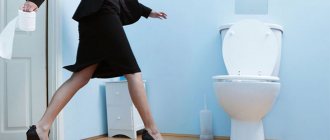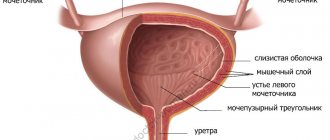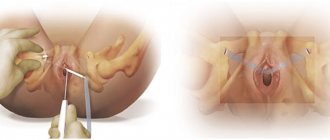Urinary incontinence: clinical picture
Involuntary discharge of urine (incontinence) is a completely uncontrollable process and occurs without any warning. The provoking factor for such an act of urination is most often physical stress caused by coughing, sneezing or laughing. The sudden release of urine occurs regardless of human biological rhythms.
Urinary incontinence in women due to coughing is much more common than in men. The disease mainly spreads among pregnant women and women who have undergone menopause. Men may suffer from sneezing and urinary incontinence after 60 or as a result of a previous disease of the genitourinary system.
Why does urinary incontinence occur?
The reason for the development of such a disorder may be the following factors:
- tumor neoplasms in the urinary system;
- infectious diseases of the genitourinary organs;
- decreased tone and weakness of the pelvic muscles;
- surgical interventions on the genitourinary organs;
- diseases of the blood vessels of the brain, causing disturbances in its activity;
- herniated intervertebral discs, spinal cord injuries and other diseases of the spine with damage to the nerve tracts emerging from it;
- increased body weight;
- psychoneurological pathologies;
- disruption of the endocrine system;
- physiological immaturity of the urinary organs.
Also in women, childbirth is a very common cause. This is due to the fact that when the fetus moves along the birth canal, the ligamentous apparatus of the small pelvis is subjected to strong stretching and sometimes rupture. And in about 25% of women, muscles and ligaments do not fully recover in the postpartum period, and this leads to involuntary and uncontrollable urine loss. In addition, such disorders worsen with age, against the background of weakening of the musculo-ligamentous apparatus.
Find out the price
Find out the price
Error! Please fill in all required fields
Thank you! We will contact you shortly
✕
Causes and provoking factors of the disease
Causes of urinary incontinence when coughing are usually caused by the following problems:
- excessive emotional stress, frequent stressful conditions;
- overweight;
- complications during pregnancy and childbirth;
- consequences of surgical interventions;
- hormonal imbalance;
- suffered severe injuries;
- smoking, alcohol abuse.
Occasional urinary incontinence in children when laughing is considered normal. Incontinence when laughing in boys is observed in 28% and usually disappears by the age of 5. And in adolescents, the incidence rate is reduced to 5%.
Urinary incontinence when laughing occurs in girls if they suffer from obesity or overactive bladder syndrome.
Features of the disease in women
Women become hostages of this situation much more often than men, this is due to the anatomical features of the female body.
The degree of stress experienced during pregnancy plays an important role. Urinary incontinence during coughing during pregnancy is a temporary phenomenon if subsequent hormonal changes do not worsen the situation. Discharge of the urethra when coughing after childbirth cannot be called the norm, because it can be one of the harbingers of serious infectious diseases.
Characteristics of symptoms
You can answer the question why urinary incontinence occurs when you cough by studying the types of involuntary urination.
- Stress incontinence. It develops more often in women due to decreased muscle tone of the pelvis. Clinical manifestations: urinary incontinence during coughing, sneezing, laughing or running.
- Urge incontinence. In this case, the urge to urinate occurs arbitrarily, and it is simply impossible to restrain them. The cause is an overactive bladder. A provoking factor for urination may be the sound of dripping water, a nervous state, or the consumption of alcoholic and coffee drinks. Symptoms may worsen during the cold season.
- Overflow incontinence. Characteristic of the male gender. The cause may be a neoplasm of the prostate gland. In this regard, there is a violation of the outflow of the urethra and overflow of the bladder, which cannot cope with a large volume of fluid.
What are the types of urinary incontinence?
There are several types of this problem:
- imperative, in which loss of urine occurs at the peak intensity of the urge to excrete it;
- reflex, the cause of which is disturbances in the conduction of nerve impulses from the brain to the muscles of the bladder, which means that a person does not feel the need to empty the bladder when it is full;
- stress, in which fluid loss occurs due to sudden pressure surges in the pelvic cavity. Jumps can be caused by sneezing, physical activity, laughter, etc.;
- constant release of small amounts of urine as a result of a combination of factors - disruption of the passage of nerve signals and pathology of the releasing sphincters;
- enuresis, that is, involuntary urination, which is observed only during night sleep.
Basic diagnostic methods
Concluding a diagnosis, carrying out therapeutic measures and preventive measures are the sphere of competence of more than one specialist. A urologist, gynecologist or neurologist can treat urinary incontinence when coughing. Due to the fact that this problem may not relate to an independent disease, but only be a symptom of it, therapeutic methods of managing the patient will be different.
Depending on the specific situation, the following diagnostic methods are used.
- Keeping a urination diary, in which the patient carefully records the amount of fluid drunk and excreted, the frequency and nature of urination.
- Visual examination for the presence of concomitant pathologies, which may be preceded by varicose veins, the presence of stretch marks in the abdominal area, hernia formations and layers of fatty tissue.
- Laboratory studies to exclude the development of infectious and inflammatory processes.
- Ultrasound examination to visualize the condition of the urethra.
- Functional tests will allow us to establish the fact of the disorder and identify its provoking factor.
- Purpose of urodynamic studies: cystomanometry and uroflowmetry.
Diagnostics
When you sneeze, urine is released - this is a symptom that requires examination. It is impossible to determine the cause of the occurrence based on one sign.
Diagnostics includes the following methods:
- Conversation. The doctor asks various questions that relate to the symptom. Basically, this is the duration of the sign, periodicity. It is necessary to describe everything that worries the person. They will also learn information about the amount of liquid you drink per day and difficulties with urination.
- Inspection. The abdominal cavity is palpated. Additionally, the doctor externally examines the entire body.
- Gynecological examination. The study is performed on women. The doctor examines the genitals.
- Prostate examination. The examination is performed on men.
- Cough test. A patient with a full bladder must be placed on a gynecological chair (women) or a couch (men). The doctor asks the person to cough. The test is performed to prove the problem that appears under stress. But if the anterior wall of the vagina and uterus is prolapsed, then this diagnostic method may show a negative result.
- Gasket test. The study is otherwise called a PAD test. The method consists of assessing urine loss by measuring the weight of the pad that was used during the period. The study can be short (from 20 to 120 minutes) or long (from 2 hours). The standard test is carried out in the clinic, and the daily test is carried out at home, but the patient must maintain his usual activity. First, the pad is weighed using scales, then it is placed on the person’s underwear. The patient is given 500 ml of clean non-carbonated water to drink, and physical activity is recommended - walking, coughing, running. After the required period of time, the gasket is removed and weighed.
- Stop test. The bladder is filled with saline solution (Sodium chloride) using a catheter. Then the person is asked to begin emptying the organ, after some time the process is interrupted. The volume of urine determines the functionality of the sphincters.
- General blood and urine analysis. As a result, it is possible to identify various deviations in indicators (hemoglobin, red blood cells, etc.).
- Bacterial culture of urine. With the help of an examination, microorganisms and their quantity can be identified.
- Blood analysis. The doctor prescribes the donation of biomaterial to determine the level of sugar and sex hormones.
- Genital smear. As a result, it is possible to determine the composition of the vaginal microflora and genital infections.
- Ultrasound examination (ultrasound) of the genitourinary organs. Carefully examine the kidneys, bladder, and uterus. As a result, it is possible to determine deviations in the size and structure of organs.
- Computer (CT) or magnetic resonance (MRI) imaging. The results result in high-quality images. Most often, MRI or CT is used to diagnose a malignant or benign tumor.
- Cystoscopy. An instrument is inserted into the bladder to examine the organ.
The cost of diagnostics varies, it all depends on the list of procedures, city, organization. Therefore, you need to find out the price in a specific clinic.
Methods of treating the disease
Medication prescription
One of the most effective methods of treating incontinence is considered to be medication. For urinary incontinence when coughing, tablets are prescribed depending on the severity of the disease, taking into account the individual characteristics of the patient’s body.
Table: Drug treatment of urinary incontinence during laughter, coughing and sneezing
| Drug group | Estimated effect | Drug name |
| Anticholinergics | Reducing sphincter spasm |
|
| Hormones | Increased estrogen levels |
|
| Nootropics | Stabilization of the functioning of the nervous system |
|
| Antimicrobial | Suppression of inflammatory processes |
|
Physiotherapeutic ways to combat the disease
For opponents of drug treatment, the question: what to do in case of urinary incontinence when sneezing remains relevant. In this case, you can try physical therapy. The most popular in medicine are:
- darsonvalization - affects the walls of the bladder, helping to stabilize its functioning;
- electrosleep – promotes relaxation of the central nervous system;
- electrophoresis - has a relaxing effect and relieves inflammatory processes.
Surgical intervention
Elimination of symptoms of urinary incontinence during laughter in women and men through surgery is quite rare. This pathology responds well to drug treatment, so surgery is performed only if the main treatment tactics have not brought a positive result.
One of the options for surgical intervention is possible.
- Sling method. The essence of the operation is the implantation of special silicone loops instead of weakened muscles, with the help of which the urethra is fixed.
- Anterior colporrhaphy. The technique is aimed at preventing sagging of the urethra by tightening the vaginal muscles. The operation is performed in two ways: through the vagina and through the abdominal cavity. The first option is more gentle and requires a shorter rehabilitation period.
- Botox injections. They are made into the walls of the bladder, helping to minimize its irritability and involuntary contraction. This operation should be repeated every six months, since the drug tends to dissolve.
Treatment of incontinence with folk remedies
When solving the problem of how to treat urinary incontinence when coughing, you should not neglect alternative medicine. For preventive purposes and as an additional therapy to the main course of treatment, folk remedies can be used.
- Dill seeds are a natural diuretic and antispasmodic that prevents uncontrolled contractions of the bladder walls. To prepare the decoction 1 tbsp. pour a spoonful of seeds into a glass of boiling water and leave for 6 hours. It is recommended to take the prepared product in the morning before meals.
- St. John's wort and centaury. A third of a glass a day, brewed with one tablespoon of herb, has a pronounced diuretic, anti-inflammatory, and antispasmodic effect.
- Corn silk. The infusion relieves inflammation and has diuretic properties. For infusion 1 tsp. The stigmas are brewed with a glass of boiling water for 30 minutes. Drink in small sips throughout the day.
Possible diseases
When you sneeze, urine is released (diagnosis is necessary) - a symptom that may indicate a disease. Detailed information is shown in the table.
| Name of the disease | Description |
| Damage to the nervous system | Involuntary loss of urine may be due to damage to the brain or spinal cord. For example, damage to the urination centers. Diseases that lead to involuntary release of fluid: 1. Atherosclerosis of cerebral vessels. Cholesterol deposits occur in the vessels that feed one of the main organs. As a result, they narrow. With the disease, the likelihood of developing acute or chronic cerebral circulatory failure increases. Additional symptoms include sleep disturbances and mental disorders (susceptibility, nervousness, irritability). At an advanced stage, the disease is characterized by tearfulness; an adult behaves like a child. 2. Stroke. This is a local violation of the blood circulation of the brain, as a result of which the cells of the organ die. Involuntary loss of urine during sneezing rarely indicates a stroke, but often occurs after the onset of the disease. 3. Damage to blood vessels and nerves as a result of diabetes. 4. Traumatic brain injury (TBI) . The person does not control urination. 5. Spinal injury. The intervertebral disc may fall out, and the hematoma will compress the nerve trunks and roots. As a result, urination becomes more frequent or involuntary. |
| Diseases of the urinary system | Urine leakage during sneezing occurs with inflammatory diseases in the kidneys or bladder. The most common of them: 1. Urethritis is an infection that results in inflammation in the urethra. Additional symptoms include discomfort and burning when emptying the bladder. A pathological secretion is released from the canal, and an increased level of leukocytes is noted in a urine test. 2. Cystitis. The pathology is characterized by an inflammatory process in the bladder. Symptoms include involuntary release of fluid and painful bowel movements. Moreover, urine leaves the body in small portions. Additionally, pain appears in the lower abdomen; it is sharp or dull. Discomfort intensifies when urinating stops. 3. Pyelonephritis is an inflammatory process in the kidneys. The disease can be one or two-sided. This pathology can appear during pregnancy, as the uterus is enlarged and puts pressure on the ureters. Pyelonephritis is also typical for older men due to a voluminous prostate, which impairs the outflow of fluid from the bladder. The disease can be acute or chronic. In the first case, pain occurs, radiating to the lower back, and the body temperature also rises. The chronic form of the disease develops in the absence of treatment for the acute stage. 4. Prostatitis. An infectious disease characteristic of men. Urinary incontinence is more pronounced in acute pathology. Additionally, there is a feeling that the bladder is not completely emptied, so the man often goes to the toilet. There may be discomfort in the lower abdomen and pain during urination. The color of the liquid changes and it becomes cloudy. A man is bothered by an erection at night, and potency decreases. 5. Prostate adenoma. This is a benign tumor that appears in men over 40 years of age. Symptoms include increased urination and sometimes having to get up to go to the toilet at night. And also the stream is weak, constantly interrupted. The man feels that his bladder is full. And also, emptying is impossible without straining. |
| Pathologies of the genital organs | Spontaneous urine leakage can occur with the following diseases: 1. Uterine fibroids. A benign tumor forms in the myometrium. Symptoms include pain that is not associated with menstruation. Also, menstruation changes its intensity, or there is no discharge at all. Additionally, the woman experiences difficulties conceiving a child. 2. Prolapse of the uterus. The organ constantly puts a lot of pressure on the sphincters. As a result, they weaken and fail to cope with their functions (retention of natural fluid). And the uterus shares a supporting structure with the bladder, so emptying the organ may become more frequent. Symptoms of uterine prolapse include pain in the lower abdomen. The woman also feels that there is a foreign object in the vagina. 3. Uterine cancer. Symptoms include blood secretions that are not associated with menstruation. If the bladder is additionally affected, urination becomes more frequent and emptying occurs involuntarily. 4. Sexually transmitted infections (STDs). Urinary incontinence is not a symptom of pathologies of this group, but can occur as one of the complications. With genital infections, inflammation develops, resulting in impaired urination. The process may be involuntary, but at first it is not so noticeable; only a few drops are released per day. |
Diet
Correction of the severity of the disease can be carried out by following basic nutritional rules until all symptoms of the disease disappear.
To do this, it is necessary to exclude those foods in the diet that irritate the bladder and provoke its contractions. These include:
- alcoholic and coffee drinks;
- sparkling water;
- spicy dishes;
- citrus;
- milk products.
It is mandatory to adhere to the drinking regime during the diet. The general recommendation is approximately 2 liters of purified water.
Surgical treatment of urinary incontinence in women
Surgery is the most effective way to solve this problem. As Dr. Nouri Jadeli explains, there are many types of surgeries (TOT, TVT, mini-TOT, Botox injections, silicone sphere injections, etc.).
There are many methods, but the goal is the same - to correct the disturbed angle between the bladder and the urethra.
The gold standard is TVT, or sling urethropexy. During the intervention, which lasts only 20-30 minutes, we place an implant (mesh) under the urinary tract, which allows urine to be drained. This is a minimally invasive operation with minimal risk of complications and a very short recovery period. According to statistics, more than 90% of patients who underwent such treatment completely got rid of episodes of involuntary urination.
The material was prepared in agreement with medical doctors.
Use of urological underwear
Urological underwear will help to minimize the negative impact of incontinence on the quality of life. These are special panties and pads that have absorbent properties. They are not able to solve the problem of urinary incontinence due to severe coughing, but they will allow you to get rid of discomfort and make it possible to lead a normal lifestyle.
Hygienic panties are selected taking into account the individual course of the disease and correspond to the degree of absorption of the secreted fluid.
Urological underwear is very comfortable, invisible under clothing, does not irritate the skin and has bactericidal properties, which prevents the development of painful complications.
How to solve the problem of stress incontinence?
Women's health researchers have repeatedly shown that patients with strong pelvic floor muscles do not have problems with urinary incontinence.
But how to restore tone to the pelvic floor muscles? As a result of clinical studies, 95% of patients solved this problem with the help of 6-10 sessions of 28 minutes on the BTL EmSella chair. And this is difficult to achieve at home.
Kegel exercises are most often recommended, but regularity is very important in this matter. If during such a workout you can perform 300–500 contractions, then in one session on the EmSella BTL chair you can perform thousands of contractions!
Preventive measures
To prevent incontinence, it is recommended to adhere to the following recommendations:
- with a dry cough, urinary incontinence most often occurs as a result of smoking - you should immediately give up the bad habit;
- systematically visit a medical facility to detect the disease at an early stage;
- monitor your weight, follow the recommendations of proper nutrition;
- avoid frequent constipation;
- control the consumption of drinks that have an irritating and diuretic effect;
- limit physical activity;
- observe the drinking regime.
Only a competent specialist can assess the severity of the disease and answer the question: what to do in case of urinary incontinence when coughing.








